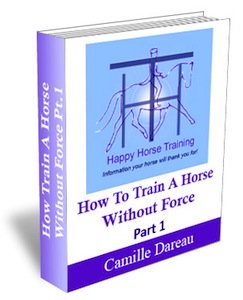| Back to Back Issues Page |
 |
|
The Whole Horse newsletter, Issue #015-- Fading Out Fear July 01, 2012 |
Fading Out FearSpotlight On Management When we integrated our foals into the main herd some months ago we hoped they would be accepted and find their places in the hierarchy without too much fuss. We didn't imagine that they would manage to influence the herd so profoundly that long standing rifts were closed up and new relationships formed. This wonderful news bears out the HHT philosophy, that when you make decisions based on love then the result is more love. In this case our compassion for the girls meant understanding that they are horses, and however well-bred and precious they are to us, life in a herd is the best gift we can offer them. Since Djinnie and Quaramba have been with the adults, one of our rescue mares, Octavia, a previously asocial and aggressive horse (see her story), has transformed into their beloved nanny figure, escorting them to the water and along the lanes to the field at night. Recently with the advent of the fly season, this mare who wouldn't allow another horse within 10 metres of herself, has been teaming up with the girls to swish flies and groom.
Octavia (grey mare in foreground) enjoying having her flies swished away by Quaramba.
For several years now there has been a major rift in the herd between the 'popular group' and the three lowest order mares. Djinnie and Quaramba are so confident and easy going - and innocent of course - that they don't see the point in such divisions, and over time they have gradually knitted the herd together. They play with the popular geldings and eat hay with the popular mares, team up with 'nanny' and go on adventures with Ellora and Jasmine at the 'bottom end' - weaving in and out until the old divisions have been increasingly eroded away.
Quaramba and Djinnie (third and fourth horses from left of picture) enjoying fly swishing with Hope, while Octavia, Ellora and Jasmine (right) - the 'lower' members of the herd hierarchy who always used to keep a good distance from the rest of the herd - now relax alongside the others.
We were naturally worried about injuries at first, and Quaramba in particular has been exercising her innate healing abilities when she strained a fetlock, got a thorn in her knee and had several cuts and scrapes on her legs as a result of exposure to herd life. However both foals have now become tough, supple-jointed and strong-limbed youngsters, fit and healthy in a way that keeping them in stables or in safe little paddocks on their own could never have done. They will continue to live the herd life throughout their dressage training and happily for them stay healthy in spirit as well as in their bodies.
The Parallels with Training When riding our horses, the same philosophy holds true. If you can ride without letting fear be your motivation, the right path will open up for you. This can be in the physical/emotional dimension, for example, if you are prepared to truly let go of the reins for long enough that you can establish a posture which balances itself, then you will experience the sensation of connection with your horse in a whole new way. Or from an intellectual point of view - instead of worrying about how much you and your horse are progressing in terms of 'results', start enjoying your time together for the unique opportunity that it is. There will always be a higher placed competitor than you, but you and your horse can have a connection which is yours alone, and there is no limit to what you can gain from it.
A recent client who - after a week of lessons mainly on the lunge, working on her seat, posture and aiding - discovered, in her words, 'a whole new world' of riding in engagement. HHT's monthly Try This At Home Tip
Positive motivation could be:
Do a little experiment and see if you can change your mind about one of your fears. Do this by identifying how it influences your management or your riding, and changing to what you would do if this fear was unfounded. Once you have stopped acting on that fear, watch out for positive results! If you want to share any experiences with this we would love to hear them.
New Pages on HHT: Dressage Saddles: Help Or Hindrance? The Ultimate Dressage Solution Horse Personality Dynamics Horse Herd Behavior Real Dressage Training Tips Testimonials Exciting News! Now Available from HHT:
With your purchase you will receive a free bonus supplement on Horse Trauma - cutting edge insights on this subject that up until now have mostly been applied only to human trauma. This supplement shows how to recognise, avoid and deal with horse trauma, which is much more common that we realise. These two e-books, comprising more than 75 thousand words and richly illustrated, are available for only 19.99 Euros (around $26). Click here for more details.
|
| Back to Back Issues Page |



